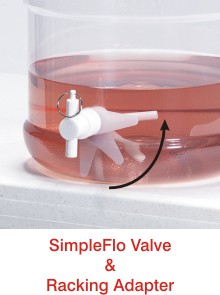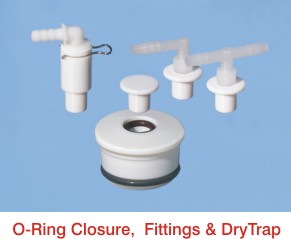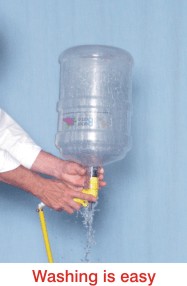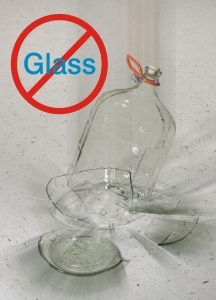|
Unbreakable The fact that BetterBottle carboys are essentially
unbreakable in normal use is a major reason for their popularity.
Most glass carboys used in winemaking and brewing are made of soft glass
(soda-lime glass), because soft glass carboys are so very much less
expensive than hard glass (borosilicate glass) carboys. Soft glass carboys
are fragile, even if they have been properly heat annealed to remove all
strain, which is not always the case. There is no way to really know the
tensile (i.e., stretch) strength of the glass with any degree of
certainty, even when the carboys are new. And simple use will make things
much more unpredictable. Wear and tear scratches and micro cracks in the
surface of the glass dramatically reduce its tensile strength. Soft glass
dissolves in water; not rapidly, but more rapidly under caustic
conditions, such as soaking in a caustic detergent. Micro cracks develop
as the glass dissolves. Simply lifting a full glass carboy by its neck can
break the neck off. Just setting a full glass carboy on the floor or on a
counter can cause the bottom to crack. One person reported losing a really
great Merlot, just before bottling, when his happy labrador wagged its
tail against the carboy. So many people have had
such experiences that tales of the disasters are a staple of home
winemaking and brewing gallows humor. But if you are seriously
injured, or in any way liable, glass carboys are no laughing matter. A
glass carboy, especially one filled with liquid, will explode into
razor-sharp shrapnel when dropped.
Unlike glass carboys, shipping BetterBottle carboys does not
require costly packaging, special handling, or extra insurance. The cost
of packing and shipping a glass carboy can be as much the cost of the
carboy itself. This is an especially serious problem for
mail-order/Internet retailers, because customers often have the impression
that the high shipping and handling charges amount to gouging:
"Why do we charge handling fees for glass
bottles and carboys? Because we use a lot of time and packing materials
to get them ready for shipment. We individually bubble-wrap each bottle!
Look at the way we pack our bottles! When we pack your glass, it gets to
you in one piece. We've tried shipping glass bottles and fermenters in
their original boxes, but the rate of breakage was very high. Moreover,
shipping insurance won't cover broken glass unless it's surrounded by 2
inches of cushioning, so broken glass shipped in the original box means
you're out of luck trying to get a refund. The handling/shipping fees
that we charge barely cover the cost of the packing materials and labor
required." Quote from the Web site of a dealer
Less taste and odor ? The
special PET resins used to make BetterBottle carboys and fittings are pure
and impart no odors or tastes; whereas, rubber and soft plastic stoppers,
hoses, and siphon tubes used with glass carboys are notorious for
contributing and transferring flavors. Use the Technical tab at the
top of page to access Flavor Scalping.
Permeability
Of all the types of plastics that can be
made into bottles and carboys, only special types of polyethylene
terephthalate (PET) have been successfully used to make containers for
carbonated beverages. The reason is simple only these special types of
PET are sufficiently impermeable to keep carbonation (i.e., carbon
dioxide) in and the oxygen out. BetterBottle fermentation carboys are made
of a unique, scientifically tested PET and they are specially manufactured
so that oxygen permeability is negligible. Use the Technical tab at the
top of page to access an informative discussion of
Permeability.
BetterBottle PET carboys are slightly more
permeable than glass; however, it would be a mistake to assume that using
a glass carboy will guarantee superior results. It is important to think
of a glass carboy as just one part of complete fermenting system
that also includes an air lock, a stopper, some hose, a racking
cane etc. In typical use, more oxygen diffuses through, or leaks by,
liquid-filled air locks and many types of stoppers (most notably silicone
rubber stoppers) than diffuses through the walls of BetterBottle
carboys and fittings. Moreover, every time a stopper is removed from a
glass carboy in order to perform a test or to make an adjustment, a
considerable amount of oxygen enters the wine or beer. Air contains about
20% oxygen. If the head space (ullage) in a carboy is just 200 ml, 40 ml
of oxygen will enter every time the stopper is removed. In fact, much more
oxygen will enter. Oxygen reacts very rapidly with wine and beer, which
essentially sucks up oxygen. Racking from an open glass carboy with a
siphon tube or pump will also expose the wine or beer to a large amount of
oxygen. In actual practice, BetterBottle carboys are equal to, or
better than, glass carboys, because BetterBottle fittings make it
convenient to control the extent to which wine or beer are exposed to
oxygen. (Use the Product
Information tab at the top of page
to access Tips on Usage.)
 Extremely light weight and easy to handle
BetterBottle carboys weigh only ~1.5 lbs (
~0.68 Kg) empty and can be easily held by their necks using just one hand.
They are designed with externally textured ribs in their sides, so they
are easy to handle when full, and their necks are strong enough to permit
the safe use of red, clamp-on, or blue, snap-on, handles. (See
Product Information tab at the top of this page.) Glass carboys weigh about
ten times as much and they are difficult and dangerous to handle, empty or
full. Extremely light weight and easy to handle
BetterBottle carboys weigh only ~1.5 lbs (
~0.68 Kg) empty and can be easily held by their necks using just one hand.
They are designed with externally textured ribs in their sides, so they
are easy to handle when full, and their necks are strong enough to permit
the safe use of red, clamp-on, or blue, snap-on, handles. (See
Product Information tab at the top of this page.) Glass carboys weigh about
ten times as much and they are difficult and dangerous to handle, empty or
full.
 Racking outlets with SimpleFlo valve
BetterBottle carboys are available ported,
so they can be fitted with a racking adapter and SimpleFlo valve. Racking
wine or beer under oxygen-free conditions is as easy as rotating the
internal stem of the adapter to just above the level of any sediment and
opening the valve. Gravity does the rest no siphon is necessary. Porting
is simply not a practical option for inexpensive, soft glass
carboys Racking outlets with SimpleFlo valve
BetterBottle carboys are available ported,
so they can be fitted with a racking adapter and SimpleFlo valve. Racking
wine or beer under oxygen-free conditions is as easy as rotating the
internal stem of the adapter to just above the level of any sediment and
opening the valve. Gravity does the rest no siphon is necessary. Porting
is simply not a practical option for inexpensive, soft glass
carboys
Thom Cannell, the Projects column
editor for Brew Your Own, liked the idea of a carboy with a spigot
so much that he wrote a lengthy column describing how to install a plastic
spigot into the side of a glass carboy. [Brew Your Own, May-June 2003, pp 53-58].
The technique he described requires about $100 dollars worth of diamond
glass drills, an electric drill, and plenty of patience. High-Q, Inc., of
which BetterBottle is a division, drills precision holes in the sides of
borosilicate glass carboys on a regular basis in order to produce its
103C-G containers, which are used for storing high-purity water in
research and medical laboratories. And High-Q engineers commend Mr.
Cannell for his excellent description. However, the engineers are quite
certain that bottles prepared as Mr. Cannell describes will be
exceptionally fragile. The costly borosilicate carboys that High-Q uses
have walls nearly 3/8" thick; whereas, the walls of inexpensive soft-glass
(soda-lime glass) carboys are likely to be uneven and as thin as 1/8".
Moreover, following the drilling operation, High-Q re-anneals its carboys
in expensive high-temperature ovens in order to remove any strain
(i.e., tension in the glass structure created by the drilling). When glass
contains strain, it is prone to cracking.
 Wide, precise opening
Glass carboys have relatively narrow (~30 mm) neck openings, making these
carboys difficult to fill and clean. The inside surfaces of their necks
are also likely to be uneven, making leaks and jammed stoppers a constant
problem. BetterBottle carboys have wide (44 mm), precise openings. The
consistency of the openings means that rubber stoppers fit better and it
is also possible to provide tough PET closures that have reliable O-ring
seals. These closures are more easily and quickly cleaned and sanitized
than rubber stoppers. (See Product
Information tab) Wide, precise opening
Glass carboys have relatively narrow (~30 mm) neck openings, making these
carboys difficult to fill and clean. The inside surfaces of their necks
are also likely to be uneven, making leaks and jammed stoppers a constant
problem. BetterBottle carboys have wide (44 mm), precise openings. The
consistency of the openings means that rubber stoppers fit better and it
is also possible to provide tough PET closures that have reliable O-ring
seals. These closures are more easily and quickly cleaned and sanitized
than rubber stoppers. (See Product
Information tab)
 Easily cleaned/sanitized
BetterBottle carboys are more easily washed and sanitized than glass
carboys. Glass is hydrophilic and scums created during fermentation tend
to stick so tightly to the walls of glass carboys that stiff brushes and
plenty of elbow grease are necessary to loosen them. Strong bleach is
often required to oxidize residual organic films. By contrast, the surface
of the special PET from which BetterBottle carboys and fittings are made
is non-porous and hydrophobic. Hot water, a good bottle cleaning
detergent, and some soaking will separate films from the walls of
BetterBottle carboys, without brushing. Also, rinsing a BetterBottle
carboy by holding it upside down in one hand and spraying a jet of water
up against the bottom with a hose nozzle is easy and effective. Don't try
that with a glass carboy! Use the Technical tab at the
top of page to access the Wash/Sanitize
section. Easily cleaned/sanitized
BetterBottle carboys are more easily washed and sanitized than glass
carboys. Glass is hydrophilic and scums created during fermentation tend
to stick so tightly to the walls of glass carboys that stiff brushes and
plenty of elbow grease are necessary to loosen them. Strong bleach is
often required to oxidize residual organic films. By contrast, the surface
of the special PET from which BetterBottle carboys and fittings are made
is non-porous and hydrophobic. Hot water, a good bottle cleaning
detergent, and some soaking will separate films from the walls of
BetterBottle carboys, without brushing. Also, rinsing a BetterBottle
carboy by holding it upside down in one hand and spraying a jet of water
up against the bottom with a hose nozzle is easy and effective. Don't try
that with a glass carboy! Use the Technical tab at the
top of page to access the Wash/Sanitize
section.
Easily stored
Because BetterBottle carboys are so light
weight, they are easy to stack in an out of the way place when they are
not being used.
|






